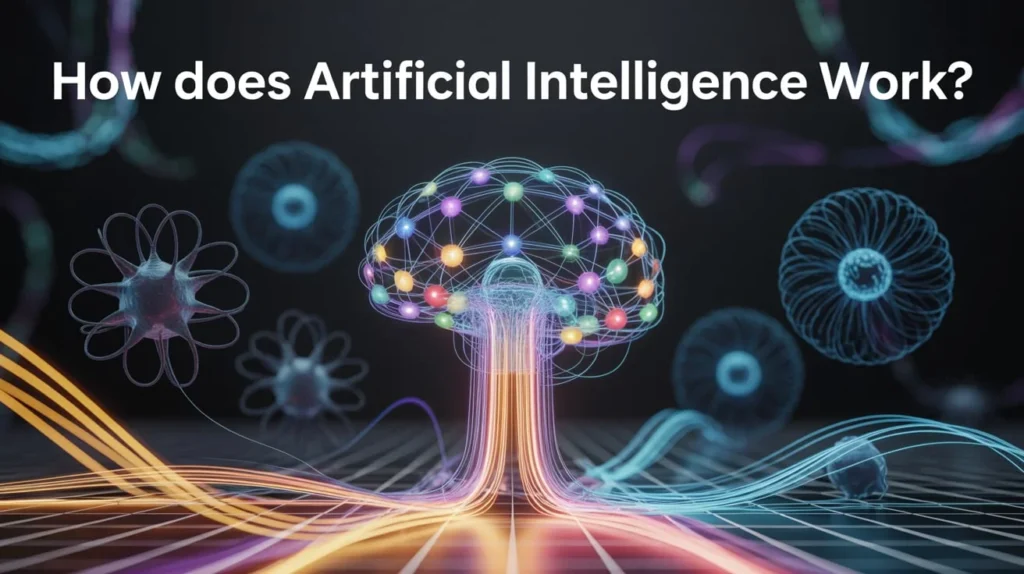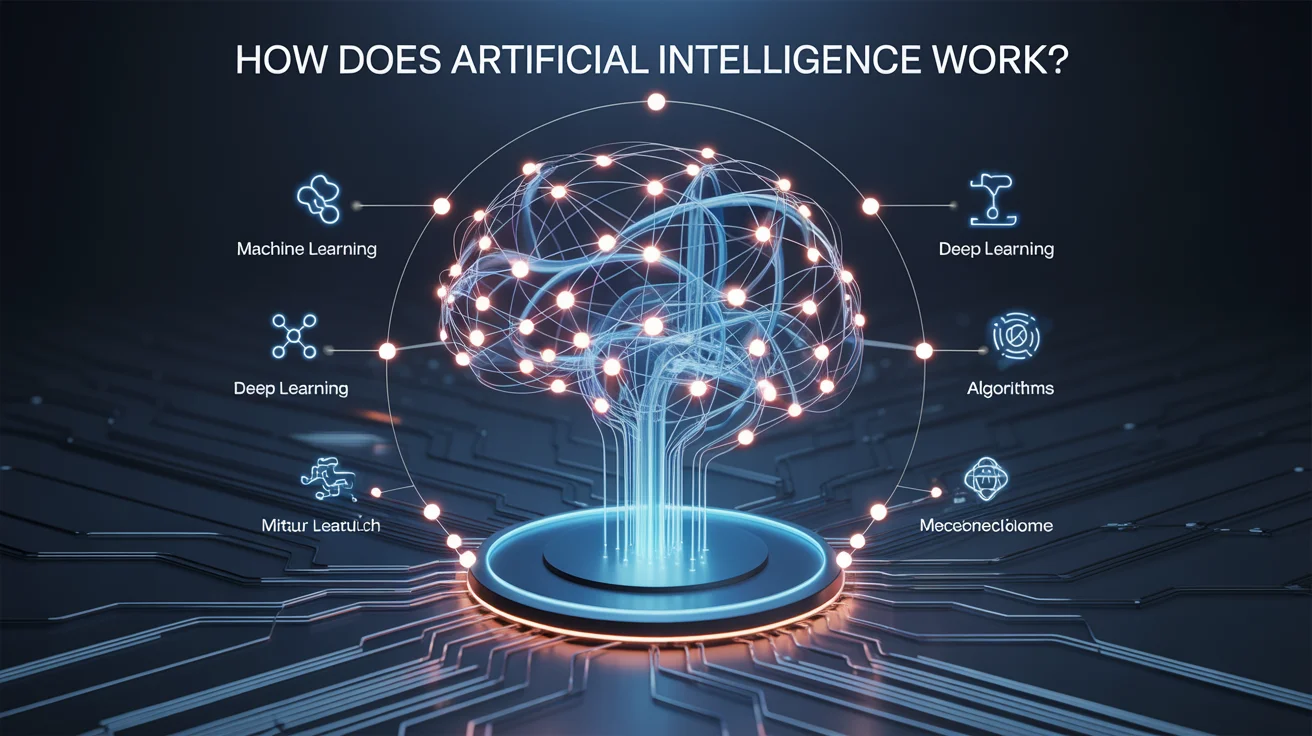Artificial Intelligence (AI) is reshaping the way we live, work, and communicate. From smartphones to smart cars, AI is silently powering many tools around us. But how does Artificial Intelligence work? That’s a question many people are asking as machines become smarter every day.
In this blog post, we’ll explore the mechanics behind AI in a simple, clear, and engaging way. We’ll uncover what makes machines think, learn, and make decisions. This guide is ideal for beginners, professionals, and anyone curious about the brain behind modern technology.
What is Artificial Intelligence?
AI is the ability of machines to perform tasks that normally require human intelligence. These tasks include learning, reasoning, problem-solving, and language understanding. AI systems are trained to mimic human behaviour using algorithms and data.
AI doesn’t mean robots taking over. Instead, it refers to software systems that can analyze, interpret, and respond to data intelligently. AI can be found in virtual assistants, recommendation systems, facial recognition, and even fraud detection.
The Core Components of AI
AI doesn’t work with magic. Behind the scenes, several key components come together to make AI function. Let’s look at the core pillars that build any AI system.
1. Machine Learning (ML):
ML is the backbone of AI. It allows machines to learn from data without being explicitly programmed. The more data it processes, the better it performs.
2. Neural Networks:
Inspired by the human brain, neural networks help machines identify patterns and solve complex problems. Deep learning, a subset of neural networks, is used in tasks like voice recognition and image classification.
Types of Artificial Intelligence

AI comes in different forms, depending on how it functions and what it can do. Let’s explore the major types of AI you might encounter.
Based on capabilities, there are three main types of AI: narrow AI, General AI, and Superintelligent AI. Most AI today is narrow AI, which means it can perform a specific task extremely well but can’t do everything a human can.
- Narrow AI: Performs specific tasks like translation or playing chess
- General AI: Can understand and learn any intellectual task like a human
- Super AI: Hypothetical AI that surpasses human intelligence in all aspects
Another way to classify AI is by its functionality. This includes reactive machines, limited memory, theory of mind, and self-aware AI.
How AI Learns From Data
For AI to work efficiently, it needs to learn from data. This learning process involves collecting, cleaning, and feeding data into algorithms. The machine analyzes patterns in the data and uses them to make predictions or decisions.
There are several types of learning methods used in AI. These include:
- Supervised Learning: The algorithm learns from labeled data
- Unsupervised Learning: The system finds hidden patterns in unlabeled data
- Reinforcement Learning: The AI learns by trial and error through rewards
With each iteration, AI systems refine their results, just like a student improving with practice.
Natural Language Processing (NLP) in AI
Natural Language Processing enables machines to understand, interpret, and generate human language. It powers voice assistants, chatbots, and translation tools.
NLP uses various techniques to analyze language, such as tokenization, sentiment analysis, and part-of-speech tagging. AI models trained in NLP can answer questions, summarize articles, and even write stories.
This is why when you speak to Siri or Chatgpt, they seem to understand your intent. NLP bridges the gap between human language and machine understanding.
How AI Makes Decisions
AI doesn’t just learn; it acts on what it knows. Once a model is trained, it can make decisions in real-time. This is done through a decision-making engine that evaluates different outcomes based on data.
For example, in self-driving cars, AI decides when to stop, accelerate, or change lanes. It does this by analyzing traffic data, road signs, and sensor inputs.
Decision-making in AI involves:
- Data collection and interpretation
- Predictive modelling and scoring
- Feedback loops for continuous learning
These steps ensure that AI remains accurate and adaptive in different scenarios.
Real-World Applications of AI
AI is already a part of our daily lives, even if we don’t realize it. The applications are endless, from personalized shopping recommendations to healthcare diagnostics.
Here are a few major areas where AI is making an impact:
- Healthcare: Disease detection, medical imaging, and drug discovery
- Finance: Credit scoring, fraud detection, and trading bots
- Retail: Product suggestions, customer service, and inventory management
- Transportation: Autonomous vehicles, route optimization, and logistics
These innovations show just how powerful and practical AI has become across industries.
Benefits and Challenges of AI
AI has many advantages. It boosts productivity, reduces human error, and handles complex problems faster than humans. However, it also has challenges.
Among the concerns are job displacement, algorithm bias, and data privacy. Ethical AI development is crucial to ensuring responsible use.
Here’s a summary of the pros and cons:
Benefits:
- Fast decision-making
- Improved accuracy
- Cost efficiency over time
Challenges:
- Job automation concerns
- Data bias and fairness
- Security and privacy issues
These must be addressed to build trust in AI systems.
Future of AI
AI is still evolving. As computing power grows and data becomes more available, AI will only get smarter. In the future, we might see more intuitive AI that can explain its decisions and interact more naturally with humans.
Trends that will shape the future:
- Explainable AI (XAI): Transparent decision-making
- AI Ethics: Ensuring fairness and inclusivity
- Human-AI Collaboration: Machines working side-by-side with people
AI’s future is not just technological, it’s also deeply human. The key is to balance power with responsibility.
Conclusion:
Understanding how does Artificial Intelligence work helps us appreciate the innovation shaping our world. From simple tasks to complex decision-making, AI relies on data, learning algorithms, and human-inspired models to function.
Its power lies not just in computation but in how we choose to use it. By guiding AI with ethics and responsibility, we can unlock its full potential and make it a positive force for society.
Frequently Asked Questions:
Q1: Is AI the same as machine learning?
No, machine learning is a subset of AI that focuses on learning from data.
Q2: Q: How does Artificial Intelligence work?
A: AI works by using algorithms and data to mimic human intelligence, enabling machines to learn, reason, and make decisions.
Q3: Is AI dangerous?
It depends on how it’s developed and used. Ethical guidelines are important.
Q4: Where is AI mainly used today?
Mainly in healthcare, finance, customer service, and transportation.
Q5: Will AI replace all jobs?
No, but it may change the nature of many jobs, creating new roles as well.




